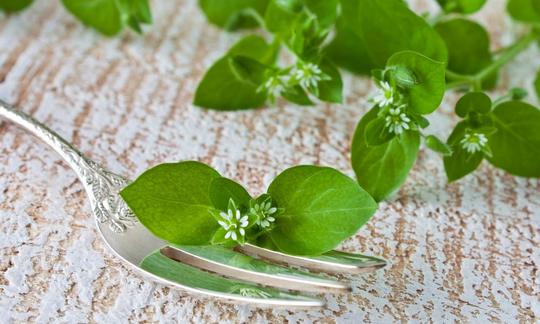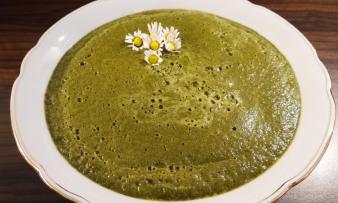Table of contents
Known since the Stone Age , common chickweed ( Stellaria media) is the most widespread, juiciest and most commonly used species of chickweed.
Use in the kitchen:
Can you eat chickweed? Chickweed is a mildly aromatic and sweet-tasting wild vegetable with a relatively tender consistency all year round. As with lettuce, the shoot tips can be harvested again and again.
What can you do with chickweed? Chickweed is a versatile wild vegetable. In raw food cooking, the nutrient-rich green parts of the plant can be processed into smoothies and herb pestos, put on bread or used as a wild plant salad. A delicious combination can be achieved with the wild plants ground elder and nettle. Cooked chickweed can be prepared like spinach and is particularly suitable as a vegetable filling, pizza topping or soup ingredient.
The seeds of this food plant can be grown as sprouts or leaf lettuce.
Vegan recipe for wild herb smoothie with chickweed:
For the raw vegan wild herb smoothie you need 12 g nettles, 4 g ground elder, 2 g chickweed, 3 g dandelion leaves, 2 g ribwort plantain, 3 g beech leaf shoots (red beech leaves), 2 g blackberry leaf shoots and 8 g yarrow. Mix the ingredients in a blender with a little water. For a thick cold soup, add just a little water, for a drinkable smoothie, add a little more. Note: This smoothie will work even if you don't have all of the wild herbs mentioned on hand. Link to the recipe.
Recipe for fresh chickweed tea:
To prepare chickweed tea, pour 1-2 tablespoons of fresh chickweed leaves and chickweed flowers (or 1 tablespoon of dried plant parts) with 250 ml of boiling hot water. After letting it steep for 5-10 minutes, drink 2-3 cups of this tea in small sips throughout the day.
A cough mixture (cough tea) with chickweed consists of equal parts chickweed herb, Iceland moss, ribwort plantain leaves, horsetail, centaury, thyme and primrose roots. 1 The cough tea is prepared as described above. It is drunk warm and sweetened with honey.
| Not only vegans or vegetarians should read this: Vegans often eat unhealthily. Avoidable nutritional mistakes. |
Purchasing - where to buy?
You can buy common chickweed fresh as so-called micro leaves, as a dried medicinal herb or as seeds for leaf lettuce online. In some pharmacies, chickweed is available as Stellariae mediae herba. However, due to its widespread distribution, the range is rather limited.
In supermarkets such as Rewe, Edeka, Spar, Coop, Migros, Aldi, Lidl, Denner, Volg, Hofer etc. or in organic supermarket chains such as Alnatura and Denns, the Chickweed is not part of the product range.
Found in the wild - Season:
Where does chickweed grow? The plant is found worldwide in temperate latitudes from the plains to the high mountains. Chickweed can be found in the wild in gardens, vineyards, fields, on paths, rubble heaps and banks. 2,3,4
Season: The main flowering period for chickweed is from March to October. Under favorable conditions (mild winter, protected growing location) the wild plant can be collected all year round. 5
The stems are tangled and brittle, with up to 2.5 cm long, entire, egg-shaped leaves. The white flowers, which are about 5 mm wide, are star-shaped and consist of five petals, five sepals and a varying number of stamens. The creeping, carpet-like plant grows to a height and width of about 5-40 cm. 5.6
Before collecting, find out about the common chickweed using fact sheets and pictures so that you can clearly identify the plant.
Storage:
Chickweed should be used fresh, frozen or gently dried. To do this, you can spread it out on a kitchen towel and leave it to dry in the fresh air. The plant parts should not be exposed to direct sunlight. If the plant parts rustle when you touch them, they are dry and you can cut them with scissors. Paper bags, metal cans or brown jars are suitable for storage. 7
Ingredients - nutritional value - calories:
Common chickweed is rich in minerals. Chickweed contains vitamin B1, vitamin B2, niacin, the trace element selenium, mucilage, saponins, flavonoids (rutin), silicon as silicic acid, gamma-linolenic acid, 5 tannins, flavonoids, 6 coumarins, oxalic acid, zinc, phosphorus, copper and essential oils. 2
Compared to lettuce, chickweed is significantly superior to classic cultivated lettuce in terms of micronutrients. Chickweed contains twice as much calcium, three times as much potassium and magnesium, seven times as much iron, twice as much vitamin A and eight times as much vitamin C. 5.8
Health aspects - effects:
How healthy is chickweed? Naturopaths recommend drinking chickweed tea for persistent coughs. 9 The saponins it contains promote the production of thin mucus for coughs and catarrh with thick mucus formation. Saponins also have anti-inflammatory and antimicrobial properties. 10
Dangers - intolerances - side effects:
In excess, the naturally occurring saponins in chickweed can cause diarrhea and vomiting and irritate the intestinal mucosa. Saponins have a hemolytic effect, ie they dissolve red blood cells. They also have irritating properties; if injected, they can damage tissue. 10 Sensitive people, pregnant women and small children should refrain from eating the wild plant or taking it internally for safety reasons. 6 You can find out more about saponins, for example, from the ingredient aquafaba.
At moderate doses, no negative side effects are known to date. 1
Use as a medicinal plant:
Chickweed is not used in modern medicine because there is no positive pharmacopoeia monograph with confirmed medicinal effects. However, the ingredients do not rule out an effect.
Folk medicine - natural medicine:
In folk medicine, chickweed is traditionally used for coughs, asthma and lung diseases, as well as to strengthen and cleanse the entire organism. Other indications are cramps, liver problems, tired and inflamed eyes, rheumatism and bladder diseases. Chickweed can be used externally for rashes, itchy skin, boils, eczema, abscesses, psoriasis, vaginitis, hives (nettle fever), burns, abrasions and minor injuries. 1,5,6
In folk medicine, chickweed is believed to have cooling, anti-inflammatory, analgesic, digestive, slightly laxative, expectorant, antipruritic, regenerative, antirheumatic and healing properties. 1,5,6
Occurrence - Origin:
The plant grows worldwide in temperate latitudes from the plains to the high mountains. 2 The exact origin of chickweed, which comes from the European-Asian region, is difficult to reconstruct today.
Growing in the garden or as a potted plant:
Chickweed can be grown easily in flat pots or window boxes in the house, on the balcony or terrace. In the garden, chickweed seeds are sown from mid-March. Chickweed prefers partially shaded areas and nutrient-rich and loamy soils. 11
Chickweed spreads quickly and like a weed. Since the host plant has shallow roots, it is relatively easy to control mechanically. Undesirable spread can be avoided by pulling out the plants before they flower or removing the flowers before the seeds ripen. 12
Danger of confusion:
Can chickweed be confused? Common chickweed cannot always be clearly distinguished from the also edible wood stitchwort ( Stellaria nemorum). The medicinal herb can also be confused with the edible, bitter-spicy tasting hornworts ( Cerastium arvense, Cerastium holosteoides). However, no harmful ingredients are known. 2.5
There is a real risk of confusion with the poisonous field pimpernel ( Anagallis arvensis). Eating it is harmful and classified as risky. Field pimpernel only flowers in summer, and is usually salmon-red, rarely white or blue. The single-row hairline on the round stem of the chickweed is a clear distinguishing feature from field pimpernel. 2.6
Animal protection - species protection - animal welfare:
Chickweed is self-fertile and does not depend on pollination by insects. 12 The seeds and (winter) green leaves are a popular food for birds. 3
General information:
The common chickweed ( Stellaria media) is the best known species of the chickweed ( Stellaria) from the carnation family (Caryophyllaceae). 3
Alternative names:
Wikipedia knows alternative names for common chickweed such as bird's-eye chickweed, chicken intestine, chicken shard, mouse intestines or cough intestine. Other well-known names in the German-speaking world are chicken bite, mouse intestine, Meier, starweed, bird's-eye chickweed and canary bird's-eye.
In English the plant is called (common) chickweed.
Literature - Sources:
Bibliography - 11 Sources (Link to the evidence)
| 1. | Pahlow, M: Das grosse Buch der Heilpflanzen. Gesund durch die Heilkräfte der Natur. 8. Auflage. Hamburg; 2019. Nikol Verlagsgesellschaft mbH & Co. KG. |
| 2. | hortipendium.de Vogelmiere. |
| 3. | Wikipedia Gewöhnliche Vogelmiere. |
| 4. | Kreuter, Marie-Luise. Der Biogarten. 25., völlig überarbeitete Auflage (Neuausgabe). München;2012. BLV Buchverlag GmbH & Co. KG. |
| 5. | Fleischhauer, Steffen Guido; Guthmann, Jürgen; Spiegelberger, Roland. Essbare Wildpflanzen. 200 Arten bestimmen und verwenden. 3. Auflage. Augsburg; 2013. Verlagsgruppe Weltbild GmbH. |
| 6. | Bown, D. Kräuter. Die grosse Enzyklopädie. Anbau und Verwendung. 2. Auflage. München; 2015. Dorling Kindersly. |
| 7. | kostbarenatur.net Kräuter richtig trocknen und das ganze Jahr über verwenden. |
| 9. | bzfe.de (Bundeszentrum für Ernährung) Vogelmiere. |
| 10. | pharmawiki.ch Saponine. |
| 11. | kraeuter-buch.de Vogelmiere. |
| 12. | gartenjournal.net Vogelmiere erfolgreich bekämpfen. |






Comments